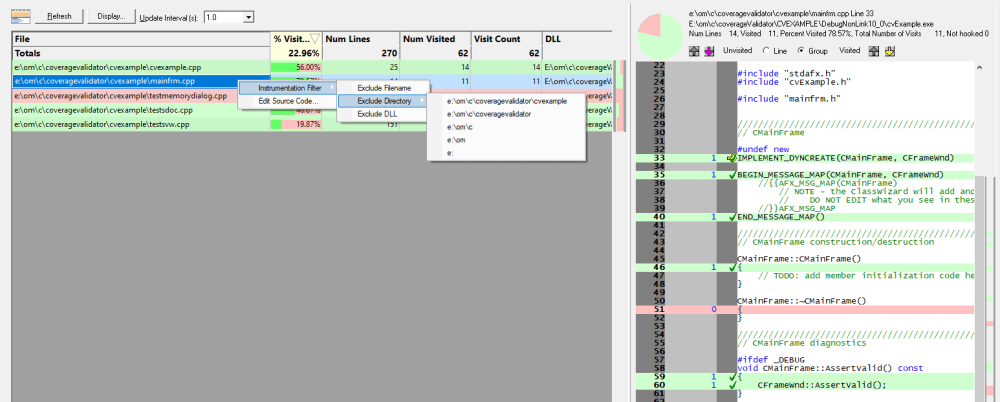The Coverage tab view displays file coverage and gives a good overall picture of the coverage.
 Read on, or click a part of the image below to jump straight to the help for that area.
Read on, or click a part of the image below to jump straight to the help for that area.
As with many of the tab views, the display is split into two resizable panes.
•the left side lists a summary of the file coverage data
•the right side shows source code for any file selected on the left
We'll cover the file list and its popup menu first, and then the source code view.
The file list
At the top of the list is a summary of the total current file coverage statistics.

Each subsequent line in the list of files displays the following:
•the file name - either the full path or the short name
•the percentage of hookable lines that have been visited
•the number of hooked lines in the file, (unhooked lines in brackets)
This is not the same as the total number of lines in a file, which may include comments, declarations and white space.
Neither is it the same as the number of hookable lines since some lines or functions can be excluded from hooking.
The count also includes lines which should have been hooked but failed, for example because the instrumentation level was set low. The unhooked line count is shown in brackets.
•the number of different lines that have been visited
•the total visit count for the file
This may be equal to the number of different lines visited unless you're counting each visit separately as seen below.

•the DLL in which the file was found
Files are ordered first by their directory and then by the files in those directories.
Line colours
Each line in the list is colour coded to indicate one of the following:
•the file has not been visited at all

•the file has been visited to some extent

•every hookable line in the file has been visited, i.e. 100% file coverage

•none of the lines in the file could be hooked

Unhooked lines
The number of unhooked lines is shown in brackets in the Num Lines column.
Depending on what file or DLL hook filters are set up, not all the hookable lines in a header file may attempt to be hooked.
Only those that are actually used (e.g. via macros or inlines) in the program may actually be hooked.
 By default, lines that could not be hooked don't stop the coverage from reaching 100%, but you can change this.
By default, lines that could not be hooked don't stop the coverage from reaching 100%, but you can change this.
In this example below, the instrumentation level was set low ('incomplete but faster') to force significant numbers of unhooked lines.
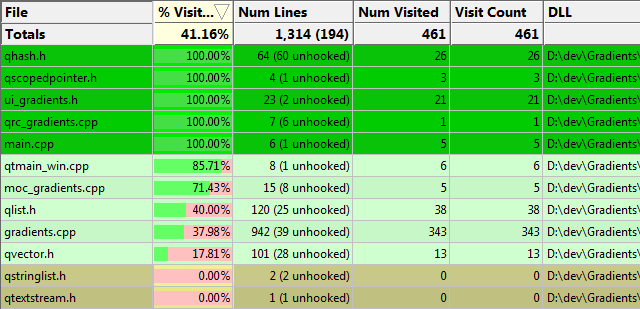
Scrollbar visualisations
To the right of each pane, beside the vertical scrollbars, you'll see a coloured area which represents the coverage.
For the file list, the visualisation shows the coverage of each file in the list - reflecting the progress meters in the second column.

For the source code view, the visualisation shows the coverage of each line in the file
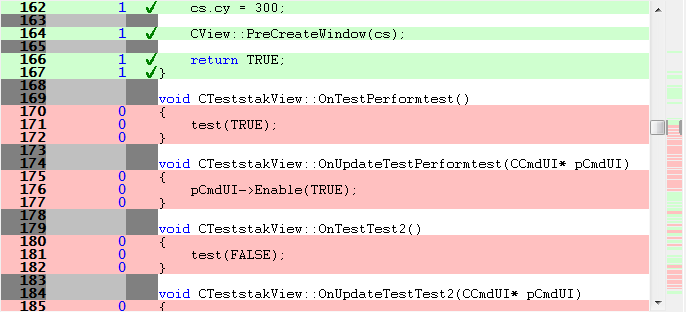
These visualisations provide a snapshot view of the whole list of files or the whole source file.
Irrespective of how much you can see in the file list or in the source code view, you can still get a global overview of the coverage distribution.
Coverage options
The coverage controls are shown below.

Window orientation
The horizontal or vertical orientation of the statistics and source code panes can be toggled with the orientation button.


Updating the display
•Update Interval (seconds)  automatically updates the display at your choice of interval between 0.1 and 60 seconds - or not at all!
automatically updates the display at your choice of interval between 0.1 and 60 seconds - or not at all!
Adjust this depending on the complexity of your application.
Only the Coverage view has automatic update intervals controlled in this way.
•Refresh  updates the display - as does the
updates the display - as does the  button on the Tools menu and toolbar
button on the Tools menu and toolbar
With an update interval set to No Update, you'll need to use this Refresh button to update the display when you wish.
Display settings
•Highlight unvisited lines  highlights rows for files and lines that have not been visited (on by default)
highlights rows for files and lines that have not been visited (on by default)
If switched off, unvisited lines appear white - or whatever colour you've set as the unselected colour.

•Show Path  shows the short file name or the longer file path in the File column of the data
shows the short file name or the longer file path in the File column of the data
File list menu options
The following popup menu is available over the data area to add filters or edit code.

 Menu options: Instrumentation Filter
Menu options: Instrumentation Filter
The instrumentation filter lets you add filters at different levels of granularity:

•Exclude Filename  adds a new filter to the Source Files Filter settings, excluding it from the results of subsequent sessions
adds a new filter to the Source Files Filter settings, excluding it from the results of subsequent sessions
•Exclude Directory  excludes all files in the same directory as the selected file
excludes all files in the same directory as the selected file
From the sub menu, choose the directory level at which you want to exclude files, right up to the drive specifier if you need to.

•Exclude DLL  excludes all files belonging to the same executable or DLL as the selected file
excludes all files belonging to the same executable or DLL as the selected file
This adds a filter to the Hooked DLLs settings.
 Filters become effective at the start of the next session. Adding a filter during a session will show the relevant rows in grey so that you can see which files would be filtered, but the coverage results will continue to be included for the rest of the current session.
Filters become effective at the start of the next session. Adding a filter during a session will show the relevant rows in grey so that you can see which files would be filtered, but the coverage results will continue to be included for the rest of the current session.
 Menu option: editing source code
Menu option: editing source code
•Edit Source Code...  opens the default or preferred editor to edit the source code
opens the default or preferred editor to edit the source code
The file source code view
Clicking on a file in the file list, shows that file in the source code view on the right.
The source code uses syntax highlighting by default, with the background colour of the line indicating if the line has been visited, is unvisited or could not be hooked.
Icons are displayed next to hooked and unhooked lines indicating visit and hook status and visit counts are shown in-line with the code.
Hovering over a line for a short period of time shows a tooltip with the number of visits to the line.
Contiguous groups of lines can be collapsed and hidden from view.
Source code file information
On the right hand panel, above the source code, you'll find some information about the source file

The details shown include the following:
•'quick view' details for visited and unvisited lines, pink for unvisited, light green for partial visited, and dark green for 100% visited


•the source code filename and the executable or DLL to which it belongs

•the same file statistics as seen in the left hand panel

Browsing visited and unvisited lines
•
 show the previous and next unvisited line of code
show the previous and next unvisited line of code
 and
and  +
+  also navigate forwards and backwards when the source code has focus.
also navigate forwards and backwards when the source code has focus.
•
 show previous and next visited line of code
show previous and next visited line of code
The arrows are grey when disabled.
 and
and  +
+  also navigate forwards and backwards through the visited lines.
also navigate forwards and backwards through the visited lines.
•Line  step by individual lines of code
step by individual lines of code
•Group  step by groups of contiguous visited or unvisited lines
step by groups of contiguous visited or unvisited lines
Keyboard access: Find and Goto
When the data view or the source code view has focus, some keyboard access is available to search for files and other text, or to navigate to numbered lines.
Find filename in data view
In the data view,  +
+  displays a dialog that will allow you to search by full or partial match for a filename.
displays a dialog that will allow you to search by full or partial match for a filename.
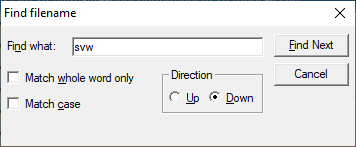
Find text in source view
In the source code view  +
+  lets you search by full or partial match anywhere in the file.
lets you search by full or partial match anywhere in the file.
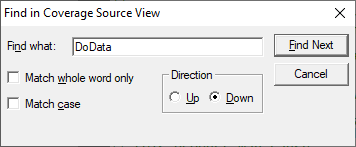
Goto line in source view
In the source code view,  +
+  displays a goto-line dialog.
displays a goto-line dialog.

.
